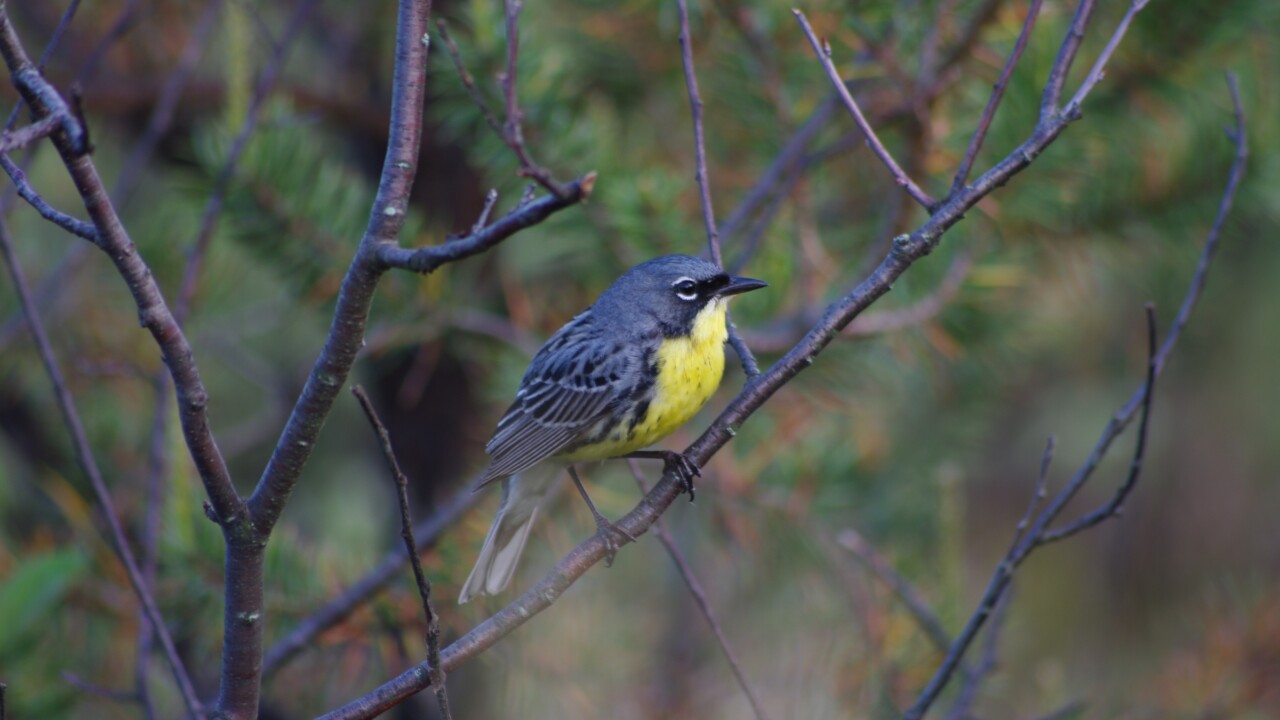(WXYZ) — The Michigan Department of Natural Resources has released the results of a 2025 census on Kirtland's Warbler in the state, showing a decline in the songbird's population.
With the release of the census, the Kirtland's Warbler Conservation Team is taking action to address the decline with the hopes of stabilizing the population in the coming years.
See video of the Kirtland's warbler in its natural habitat below
According to the DNR, there are 1,477 breeding pairs of Kirtland's warblers in Michigan. The state is home to 98% of the global population, with the rest located in Wisconsin and Ontario. The last census, in 2021, found there to be a global population of 2,245 pairs.
The survey was conducted between June 6-26 in the northern Lower Peninsula and Upper Peninsula. The census found:
- 814 pairs of Kirtland’s warblers on DNR-managed land in the northern Lower Peninsula.
- 597 pairs on Forest Service land in the northern Lower Peninsula.
- 49 pairs on DNR-managed land in the Upper Peninsula.
- 17 pairs on Forest Service land in the Upper Peninsula.
- Small numbers of the songbird also live in Wisconsin and Ontario (in 2021, Ontario reported 22 pairs).
The Kirtland's Warbler Conservation Team is a network that includes the Michigan DNR, U.S. Fish and Wildlife Service, U.S. Forest Service, Wisconsin Department of Natural Resources, American Bird Conservancy, Huron Pines and more.
According to the team, the decline is projected to continue over the next few years before efforts can stabilize the population and help manage the birds' habitats.
“This is a situation we’ve been monitoring and addressing for several years now,” Erin Victory, a wildlife biologist and Kirtland’s warbler management coordinator for the Michigan DNR, said in a statement. “From a habitat management perspective, we anticipated a decline in the population and have been taking action to address it. We are confident we have enough tools and resources available to us, collectively within the conservation team, to reverse the decline and stabilize the population.”
According to the DNR, one reason for the decline is reduced acreage of breeding habitat. The Kirtland's warbler is ground-nesting and relies on young jack pine forests to breed. The state said there aren't currently enough young jack pine stands to maintain a stable population, so the team plans to adjust the tree-harvesting strategy to create more breeding habitats in designated areas.
The goal, according to the conservation team, is to maintain at least 1,000 pairs of Kirtland's warblers. So, they plan to sell timber to clearcut mature jack pine and then plant new jack pine seedlings to create young forests.
“While a population decline is not what we wanted to see this census, it is encouraging that we already understand the principal cause and conservation team members are taking steps to address the issue,” Steve Roels, coordinator of the Kirtland’s Warbler Conservation Team and Kirtland’s warbler program director for the American Bird Conservancy, added in a statement.
According to the conservation team, the goal is to develop a 10-year plan to manage the habitat and stabilize the population.
Other strategies include moving away from jack pine plantations in favor of natural regeneration and partnering with university researchers to evaluate new management techniques.
The Kirtland's warbler was federally endangered for nearly 50 years, and in the 1970s and 1980s, the population dropped to fewer than 200 pairs. A decades-long collaborative effort has built the population back up, and it was removed from the endangered species list in 2019. It remains a state-threatened species in Michigan, and the majority of the population is in 10 counties in the northern Lower Peninsula.
“The Kirtland’s Warbler Conservation Team is a highly collaborative group that has been working to ensure the survival of the Kirtland’s warbler for more than 50 years,” said Phil Huber, a wildlife biologist and chair of the conservation team. “I am confident that this group will continue to do what is necessary for this at-risk species and other plants and animals in the jack pine ecosystem.”



